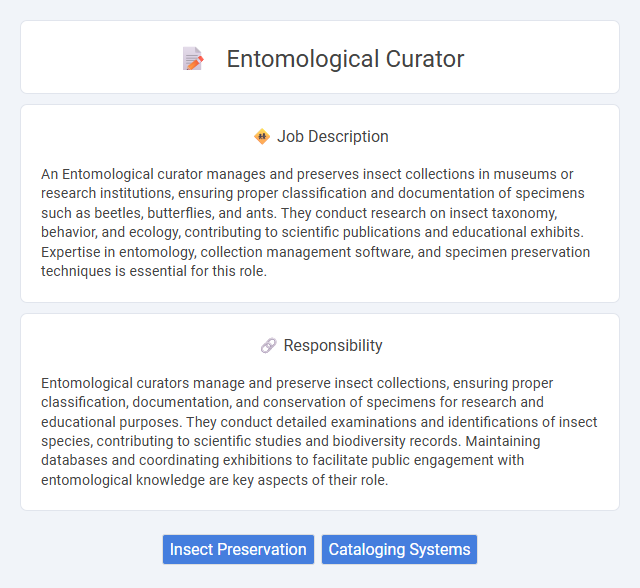
An Entomological curator manages and preserves insect collections in museums or research institutions, ensuring proper classification and documentation of specimens such as beetles, butterflies, and ants. They conduct research on insect taxonomy, behavior, and ecology, contributing to scientific publications and educational exhibits. Expertise in entomology, collection management software, and specimen preservation techniques is essential for this role.
Individuals with a strong passion for insects and detail-oriented skills are likely suitable for an entomological curator position. Those who have patience, organizational abilities, and enjoy research may find this role fulfilling and manageable. People who prefer dynamic social interactions might find the solitary and meticulous nature of curation less compatible with their preferences.
Qualification
A successful entomological curator typically holds an advanced degree in entomology, biology, or a related field, often requiring a master's or PhD for specialized collections management. Expertise in insect taxonomy, specimen preservation techniques, and database management is essential for accurate collection curation and research facilitation. Experience with museum protocols, scientific research, and public education enhances a curator's qualifications to maintain and expand entomological collections effectively.
Responsibility
Entomological curators manage and preserve insect collections, ensuring proper classification, documentation, and conservation of specimens for research and educational purposes. They conduct detailed examinations and identifications of insect species, contributing to scientific studies and biodiversity records. Maintaining databases and coordinating exhibitions to facilitate public engagement with entomological knowledge are key aspects of their role.
Benefit
Working as an entomological curator likely offers the benefit of access to extensive insect collections, which supports research and education in entomology. This role probably provides opportunities to collaborate with scientists, contributing to biodiversity conservation and species identification. It may also involve public outreach, enhancing awareness and appreciation of insect diversity.
Challenge
The role of an entomological curator likely involves navigating the challenge of preserving delicate insect specimens while ensuring accurate scientific documentation and public accessibility. Managing extensive collections requires meticulous attention to detail and the ability to adapt to evolving curation methods and technologies. Balancing research demands with educational outreach may present ongoing difficulties in prioritizing time and resources.
Career Advancement
Entomological curators manage insect collections, conduct research, and contribute to scientific publications, positioning themselves as experts in taxonomy and biodiversity. Advancing in this career often involves pursuing advanced degrees such as a master's or PhD, gaining experience through museum work or field research, and developing skills in specimen preservation and digital cataloging. Leadership roles like head curator or director of natural history collections are attainable through proven expertise, project management, and active participation in professional entomological societies.
Key Terms
Insect Preservation
An entomological curator specializing in insect preservation manages extensive insect collections by employing advanced techniques such as pinning, alcohol preservation, and freeze-drying to maintain specimen integrity. Responsibilities include cataloging, documenting, and conserving diverse insect species to support research, education, and biodiversity studies. Proficiency in environmental controls and pest management is essential to prevent degradation and ensure long-term preservation of specimens.
Cataloging Systems
Entomological curators specialize in managing and preserving insect collections through advanced cataloging systems that enable precise identification, classification, and data retrieval. They utilize digital databases integrating metadata such as species taxonomy, collection locality, and specimen condition to enhance research accessibility and biodiversity studies. Expertise in taxonomy, database management software, and specimen preservation techniques ensures accurate catalog maintenance and supports scientific collaboration.
 kuljobs.com
kuljobs.com